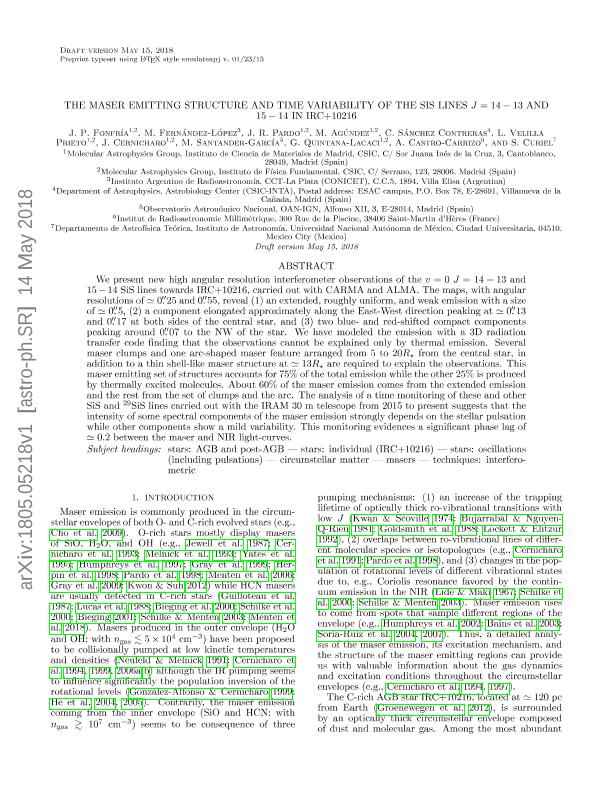Mostrar el registro sencillo del ítem
dc.contributor.author
Fonfra, J. P.
dc.contributor.author
Fernandez Lopez, Manuel

dc.contributor.author
Pardo, J. R.
dc.contributor.author
Agúndez, M.
dc.contributor.author
Sánchez Contreras, C.
dc.contributor.author
Velilla Prieto, L.
dc.contributor.author
Cernicharo, J.
dc.contributor.author
Santander García, M.
dc.contributor.author
Quintana Lacaci, G.
dc.contributor.author
Castro Carrizo, A.
dc.contributor.author
Curiel, S.
dc.date.available
2019-08-28T18:20:04Z
dc.date.issued
2018-06
dc.identifier.citation
Fonfra, J. P.; Fernandez Lopez, Manuel; Pardo, J. R.; Agúndez, M.; Sánchez Contreras, C.; et al.; The Maser-emitting Structure and Time Variability of the SiS Lines J = 14-13 and 15-14 in IRC+10216; IOP Publishing; Astrophysical Journal; 860; 2; 6-2018; 1-18
dc.identifier.issn
0004-637X
dc.identifier.uri
http://hdl.handle.net/11336/82399
dc.description.abstract
We present new high angular resolution interferometer observations of the v = 0 J = 14-13 and 15-14 SiS lines toward IRC+10216, carried out with the Combined Array for Research in Millimeter-wave Astronomy and the Atacama Large Millimeter Array. The maps, with angular resolutions of ≃0.″25 and 0.″55, reveal (1) an extended, roughly uniform, and weak emission with a size of ≃0.″5; (2) a component elongated approximately along the east-west direction peaking at ≃0.″13 and 0.″17 at both sides of the central star; and (3) two blue- and redshifted compact components peaking around 0.″07 to the NW of the star. We have modeled the emission with a 3D radiation transfer code, finding that the observations cannot be explained only by thermal emission. Several maser clumps and one arc-shaped maser feature arranged from 5 to 20 from the central star, in addition to a thin shell-like maser structure at ≃13 , are required to explain the observations. This maser-emitting set of structures accounts for 75% of the total emission, while the other 25% is produced by thermally excited molecules. About 60% of the maser emission comes from the extended emission, and the rest comes from the set of clumps and the arc. The analysis of a time monitoring of these and other SiS and 29SiS lines carried out with the IRAM 30 m telescope from 2015 to present suggests that the intensity of some spectral components of the maser emission strongly depends on the stellar pulsation, while other components show a mild variability. This monitoring evidences a significant phase lag of ≃0.2 between the maser and near-IR light curves.
dc.format
application/pdf
dc.language.iso
eng
dc.publisher
IOP Publishing

dc.rights
info:eu-repo/semantics/openAccess
dc.rights.uri
https://creativecommons.org/licenses/by-nc-sa/2.5/ar/
dc.subject
Circumstellar Matter
dc.subject
Masers
dc.subject
Stars: Agb And Post-Agb
dc.subject
Stars: Individual (Irc+10216)
dc.subject
Stars: Oscillations
dc.subject
Techniques: Interferometric
dc.subject.classification
Astronomía

dc.subject.classification
Ciencias Físicas

dc.subject.classification
CIENCIAS NATURALES Y EXACTAS

dc.title
The Maser-emitting Structure and Time Variability of the SiS Lines J = 14-13 and 15-14 in IRC+10216
dc.type
info:eu-repo/semantics/article
dc.type
info:ar-repo/semantics/artículo
dc.type
info:eu-repo/semantics/publishedVersion
dc.date.updated
2019-08-16T16:49:13Z
dc.journal.volume
860
dc.journal.number
2
dc.journal.pagination
1-18
dc.journal.pais
Reino Unido

dc.journal.ciudad
Londres
dc.description.fil
Fil: Fonfra, J. P.. Consejo Superior de Investigaciones Científicas; España
dc.description.fil
Fil: Fernandez Lopez, Manuel. Provincia de Buenos Aires. Gobernación. Comisión de Investigaciones Científicas. Instituto Argentino de Radioastronomía. Consejo Nacional de Investigaciones Científicas y Técnicas. Centro Científico Tecnológico Conicet - La Plata. Instituto Argentino de Radioastronomía; Argentina
dc.description.fil
Fil: Pardo, J. R.. Consejo Superior de Investigaciones Científicas; España
dc.description.fil
Fil: Agúndez, M.. Consejo Superior de Investigaciones Científicas; España
dc.description.fil
Fil: Sánchez Contreras, C.. Consejo Superior de Investigaciones Científicas; España
dc.description.fil
Fil: Velilla Prieto, L.. Consejo Superior de Investigaciones Científicas; España
dc.description.fil
Fil: Cernicharo, J.. Consejo Superior de Investigaciones Científicas; España
dc.description.fil
Fil: Santander García, M.. Observatorio Astronomico Nacional; España
dc.description.fil
Fil: Quintana Lacaci, G.. Consejo Superior de Investigaciones Científicas; España
dc.description.fil
Fil: Castro Carrizo, A.. Institut de Radioastronomie Millimétrique; Francia
dc.description.fil
Fil: Curiel, S.. Universidad Nacional Autónoma de México; México
dc.journal.title
Astrophysical Journal

dc.relation.alternativeid
info:eu-repo/semantics/altIdentifier/doi/http://dx.doi.org/10.3847/1538-4357/aac5e3
dc.relation.alternativeid
info:eu-repo/semantics/altIdentifier/url/https://iopscience.iop.org/article/10.3847/1538-4357/aac5e3
dc.relation.alternativeid
info:eu-repo/semantics/altIdentifier/url/https://www.ncbi.nlm.nih.gov/pmc/articles/PMC6029660/
Archivos asociados
